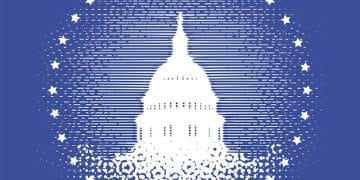US Corporate Tax Incentives 2025: What Businesses Need to Know

Advertisements

The new corporate tax incentives slated for 2025 in the United States aim to stimulate economic growth and innovation, offering businesses various deductions, credits, and revised depreciation rules that could significantly impact their financial strategies and operational planning.
Advertisements
As the economic landscape constantly shifts, businesses in the United States face an ongoing challenge to adapt and optimize their financial strategies.
For 2025, a fresh set of corporate tax incentives is on the horizon, promising to reshape how companies invest, innovate, and ultimately thrive.
Understanding what the new corporate tax incentives mean for US businesses in 2025 is not merely a matter of compliance; it’s a strategic imperative that could unlock significant opportunities for growth and efficiency.
Advertisements
Understanding the Landscape of Corporate Tax Reform
The intricate world of corporate taxation is rarely static, and the United States is no exception. Businesses constantly navigate a complex web of regulations, seeking pathways to optimize their financial health while contributing to economic growth.
The anticipated corporate tax incentives for 2025 represent more than just minor adjustments;
they signal a potential shift in fiscal policy designed to encourage specific business behaviors, such as investment in domestic manufacturing, green technologies, and research and development.
These incentives are often born from a confluence of economic objectives and political priorities. Policymakers deliberate on how tax levers can best stimulate job creation, enhance global competitiveness, and foster innovation within the American economy.
Consequently, understanding the underlying philosophy behind these reforms is as crucial as grasping the specifics of the new codes. It helps businesses anticipate future changes and align their long-term strategies with national economic goals.
Key Drivers Behind the 2025 Incentives
Several factors typically drive changes in corporate tax policy. Economic performance, global competitiveness, and the need to address specific societal challenges often play significant roles.
For 2025, these drivers may include a renewed focus on supply chain resilience, accelerated digital transformation, and sustainable practices.
The incentives are often structured to reward companies that contribute positively to these areas.
- 📈 Economic Growth: Stimulating domestic investment and job creation.
- 🌎 Global Competitiveness: Ensuring US businesses can compete effectively on the international stage.
- 🌱 Green Initiatives: Encouraging adoption of environmentally friendly practices and technologies.
- 🔬 Innovation & R&D: Fostering advancements in technology and new product development.
The historical context of US tax policy also provides valuable insight. Past reforms, such as the Tax Cuts and Jobs Act of 2017, have dramatically altered the corporate tax environment.
These prior changes serve as a precedent, informing both the government’s approach to new incentives and businesses’ expectations regarding their potential impact.
Therefore, the 2025 incentives are not isolated events but rather part of an ongoing evolution in fiscal strategy.
Ultimately, these incentives are designed to create a more dynamic and responsive economic environment. For businesses, this means a continuous need for vigilance and adaptability.
Staying informed about the nuances of these changes and their potential ramifications is paramount for effective strategic planning and ensuring long-term financial stability.
Decoding the New Depreciation Rules and Capital Expenditures
Depreciation rules and the treatment of capital expenditures are fundamental pillars of corporate taxation that directly impact a company’s profitability and investment decisions.
For many businesses, the ability to deduct the cost of assets over time significantly reduces their taxable income.
The new corporate tax incentives for 2025 are expected to introduce notable changes in these areas, potentially offering new avenues for businesses to accelerate cost recovery and encourage capital investment.
Understanding these updated rules is critical, as they can influence everything from equipment purchasing decisions to long-term strategic investments in infrastructure and technology.
Businesses that effectively navigate these changes can unlock substantial tax savings, freeing up capital for further growth, innovation, or expansion.
Conversely, overlooking these details could lead to missed opportunities and an unoptimized tax position.
Accelerated Depreciation Provisions
One of the most impactful changes often seen in tax incentive packages relates to accelerated depreciation. This allows businesses to deduct a larger portion of an asset’s cost in its early years, rather than spreading it out evenly over its useful life.
For 2025, there may be provisions aimed at stimulating immediate investment, particularly in sectors deemed critical for national economic security or technological advancement.
- 💰 Bonus Depreciation: Potential expansion or modification of current bonus depreciation rules.
- 🛠️ Section 179 Expensing: Higher limits or broader eligibility for immediate expensing of certain assets.
- 🏗️ Real Estate Improvements: Specific accelerated options for qualified improvement property.
These provisions are not just about tax savings; they are powerful tools for encouraging businesses to upgrade equipment, invest in new facilities, and adopt modern technologies more quickly.
The financial benefit of accelerated depreciation can significantly improve cash flow in the short term, which is particularly attractive for businesses facing rapid technological obsolescence or high initial investment costs.
Moreover, the proposed changes could also affect how capital expenditures are classified and recognized.
There might be clearer guidance or revised definitions for what qualifies as a capital expenditure versus a deductible expense, which could have implications for budgeting and financial reporting.
Therefore, a thorough review of internal accounting practices in light of these new rules will be essential for compliance and optimization.
In essence, the alterations to depreciation and capital expenditure rules underscore a broader governmental effort to inject dynamism into the economy.
Businesses must remain agile, proactively evaluating how these changes can be leveraged to their strategic advantage, ensuring every investment decision aligns with the most favorable tax treatment available under the new 2025 framework.
Enhanced Credits for Research and Development (R&D)
Innovation is typically the lifeblood of competitive economies, and the United States has long recognized the importance of encouraging it through tax policy.
The 2025 corporate tax incentives are anticipated to bring significant enhancements to the Research and Development (R&D) tax credit program.
A move designed to spur technological advancements and maintain the nation’s leadership in critical scientific and engineering fields.
For businesses investing in new products, processes, or technologies, these enhanced credits could represent a powerful financial boon.
The R&D tax credit typically allows companies to reduce their tax liability based on qualified research expenses.
When these credits are enhanced, it means more types of activities might qualify, the credit rates could increase, or the mechanisms for claiming them might become more accessible.
This directly translates into lower costs for innovation, making high-risk, high-reward research more financially viable for a broader range of companies, from startups to established enterprises.
Expanding Eligibility and Increasing Credit Rates
One of the key areas of enhancement for R&D credits often involves broadening the definition of what constitutes “qualified research.”
This could mean including more types of software development, certain incremental improvements to existing products, or even research conducted in collaboration with academic institutions.
Additionally, an increase in the credit rates themselves would directly magnify the financial benefit companies receive for their innovation efforts.
- 📈 Broader Scope: New types of innovative activities becoming eligible for credits.
- 💲 Higher Returns: Increased percentage of qualified expenses claimable as credits.
- 💼 Easier Access: Simplified documentation requirements for small and medium-sized businesses.
These changes are expected to particularly benefit industries that are heavily reliant on continuous innovation, such as technology, pharmaceuticals, manufacturing, and renewable energy.
By reducing the financial burden associated with R&D, the government aims to accelerate the pace of invention, leading to new industries, job creation, and a stronger global competitive standing for US businesses.
Furthermore, there may be specific provisions aimed at encouraging R&D in areas deemed of national importance, such as artificial intelligence, biotechnology, or advanced materials.
Businesses operating in these strategic sectors might find their research initiatives receiving even more favorable tax treatment, creating a clear incentive to align their innovation pipelines with national priorities.
In conclusion, the enhanced R&D credits for 2025 offer a compelling reason for businesses to re-evaluate their innovation strategies.
Companies that proactively identify and document their qualified research activities will be best positioned to capitalize on these new incentives, transforming their investment in future technologies into tangible tax savings and a stronger competitive edge.
Incentives for Green Initiatives and Sustainable Practices

With growing global awareness of climate change and environmental stewardship, the push towards sustainable business practices has intensified.
The 2025 corporate tax incentives are anticipated to heavily feature provisions designed to encourage green initiatives, aligning economic growth with environmental responsibility.
For US businesses, this signals a clear opportunity to invest in energy efficiency, renewable energy sources, and other sustainable operations, thereby not only reducing their environmental footprint but also realizing significant financial benefits through tax relief.
These incentives often come in various forms, such as tax credits for adopting clean energy technologies, deductions for sustainable manufacturing processes, or grants for developing environmentally friendly products.
The overarching goal is to accelerate the transition to a lower-carbon economy, making it more attractive for companies to lead in sustainability rather than merely comply with regulations.
Businesses that strategically integrate green initiatives into their core operations stand to gain a competitive advantage, appealing to environmentally conscious consumers and investors alike.
Driving Investment in Renewable Energy and Efficiency
A primary focus of green tax incentives often lies in promoting renewable energy adoption.
This could involve enhanced credits for installing solar panels, wind turbines, or geothermal systems, making these significant upfront investments more financially palatable.
Similarly, incentives for improving energy efficiency, through upgrades to HVAC systems, better insulation, or smart building technologies, are expected to offer substantial tax savings.
- ☀️ Renewable Energy Credits: Boosting investment in solar, wind, and other clean power sources.
- 💡 Energy Efficiency Deductions: Incentivizing upgrades to improve building and operational efficiency.
- ♻️ Sustainable Manufacturing: Credits for reducing waste, water usage, and carbon emissions in production.
Beyond direct energy initiatives, the 2025 incentives may also extend to broader sustainable practices.
This could include tax breaks for companies that invest in carbon capture technologies, develop recyclable materials, or significantly reduce their overall waste generation.
Such provisions encourage a holistic approach to sustainability, rewarding businesses for their comprehensive efforts to minimize environmental impact.
Moreover, these green incentives are not just about reducing costs; they often enhance a company’s brand image and appeal. Demonstrating a commitment to sustainability can attract talent, improve customer loyalty, and open doors to new markets.
Therefore, evaluating the 2025 green tax incentives should be viewed not just as a compliance exercise, but as a strategic opportunity to future-proof a business and align it with evolving market values.
Ultimately, the upcoming tax reforms provide a compelling framework for businesses to embrace sustainability more fully.
By carefully planning and executing projects that qualify for these incentives, US companies can contribute to a healthier planet while simultaneously bolstering their financial health and long-term viability.
Navigating International Tax Implications and Global Competitiveness
In an increasingly interconnected global economy, US businesses frequently operate across international borders, making international tax implications a critical consideration.
The new corporate tax incentives for 2025 are not designed in isolation; they are part of a broader strategy to enhance American competitiveness on the world stage.
These reforms could impact how US companies conduct business overseas, manage their global supply chains, and structure their international operations, emphasizing the need for a sophisticated understanding of cross-border tax regulations.
Changes in international tax provisions often seek to balance encouraging domestic investment with ensuring fair taxation of foreign earnings.
This delicate equilibrium can significantly influence decisions regarding where companies locate their operations, where they register intellectual property, and how they repatriate profits.
Businesses with a global footprint must therefore carefully analyze how the 2025 incentives interact with existing international tax agreements and the tax laws of other countries.
Impact on Foreign-Derived Intangible Income (FDII) and GILTI
Two key areas of international taxation that have received significant attention in recent years are Foreign-Derived Intangible Income (FDII) and Global Intangible Low-Taxed Income (GILTI).
The 2025 incentives might bring adjustments to these provisions, which were initially designed to encourage the retention of intellectual property in the US and to tax certain foreign earnings of US companies.
- 🌍 FDII Adjustments: Potential revisions to how income derived from foreign sales of US-developed intangibles is taxed.
- 💸 GILTI Modifications: Changes to the minimum tax on global intangible low-taxed income earned by foreign subsidiaries.
- 📦 Supply Chain Reshoring: Incentives aimed at bringing manufacturing and strategic supply chains back to the US.
Any modifications to FDII and GILTI could significantly alter the effective tax rate for multinational corporations, influencing their decisions on where to develop and hold intellectual property and how to manage their global profit allocations.
These changes are typically geared towards making the US a more attractive location for innovation and high-value economic activities.
Beyond these specific provisions, the 2025 tax package could also include broader incentives for reshoring manufacturing and supply chain operations.
This could involve tax credits for expenses related to relocating production facilities to the US, or deductions for investments in domestic infrastructure that supports national industries.
Such measures are vital for enhancing national economic resilience and reducing dependence on foreign supply chains.
Ultimately, navigating the international dimensions of the 2025 corporate tax incentives requires a detailed understanding of both domestic policy objectives and the global tax landscape.
Businesses must engage in proactive tax planning, consulting with international tax experts to ensure compliance while maximizing the benefits of any new provisions designed to bolster global competitiveness.
Sector-Specific Adjustments and Targeted Relief
While many corporate tax incentives apply broadly across all industries, new legislative packages often include sector-specific adjustments and targeted relief measures.
For 2025, the new corporate tax incentives are likely to feature provisions tailored to specific industries or types of businesses that are deemed critical for economic growth, national security, or social welfare.
These targeted interventions acknowledge that different sectors face unique challenges and opportunities, requiring bespoke tax solutions to foster their development.
Understanding these sector-specific incentives is paramount for businesses operating in affected industries. What might be a minor tax adjustment for one sector could represent a significant competitive advantage or a crucial lifeline for another.
Companies must therefore diligently scrutinize the new regulations to identify any provisions that directly apply to their industry, allowing them to capitalize on opportunities for specialized tax relief or investment encouragement.
Incentives for Small Businesses and Startups
Small businesses and startups are often seen as the engine of job creation and innovation, yet they frequently face disproportionate hurdles.
The 2025 incentives may include specialized tax credits, simplified deduction processes, or enhanced startup expense allowances designed to ease the financial burden on these burgeoning enterprises.
These measures are critical for fostering entrepreneurship and ensuring that new businesses have the financial runway to grow and contribute to the economy.
- 🚀 Startup Tax Credits: Specific credits for initial operating costs or early-stage R&D.
- 🤝 Small Business Deductions: Enhanced deductions for certain business expenses or pass-through income.
- 💼 Access to Capital: Tax incentives for investors supporting qualified small business ventures.
Furthermore, critical sectors such as healthcare, education, or agriculture might receive their own set of unique incentives.
For instance, there could be expanded tax credits for healthcare providers investing in rural facilities, or new deductions for agricultural businesses adopting sustainable farming practices.
These provisions reflect a strategic government effort to bolster essential services and industries that are foundational to the nation’s well-being.
The tech sector, particularly in areas like cybersecurity, artificial intelligence, and quantum computing, could also be a recipient of targeted tax relief.
Such incentives would aim to solidify the US’s position as a global leader in technological innovation, encouraging investment and talent retention in these high-growth fields.
In essence, beyond the broad-stroke changes, businesses must vigilantly seek out the granular details of the 2025 tax incentives.
Identifying and leveraging sector-specific adjustments can provide a powerful competitive edge, enabling companies to optimize their tax strategies and channel resources into growth areas that align with both their business objectives and national economic priorities.
Strategic Planning and Compliance in the New Era

The introduction of new corporate tax incentives in 2025, while offering numerous opportunities, inherently brings complexities for strategic planning and compliance.
For US businesses, simply acknowledging these changes is insufficient; a proactive and meticulous approach is required to fully leverage the benefits while adhering to evolving regulatory frameworks.
This involves a comprehensive review of current financial strategies, forecasting potential impacts, and adjusting operational practices to align with the new tax environment.
Strategic tax planning in this new era means moving beyond mere year-end compliance to integrate tax considerations into every major business decision.
From capital investment to human resource management and supply chain design, understanding the tax implications upfront can lead to optimized outcomes.
Furthermore, the focus on compliance remains paramount, as tax authorities typically scrutinize new incentive claims closely, requiring robust documentation and transparent reporting.
Best Practices for Adapting to New Tax Regulations
Effective adaptation to the 2025 tax incentives requires a multi-faceted approach. Businesses should begin by conducting a thorough assessment of their current tax position and how potential changes might affect it.
This includes quantifying the projected benefits of new credits and deductions, as well as anticipating any increased compliance burdens.
- 📝 Proactive Assessment: Evaluate current tax strategies against the new 2025 incentives.
- 🔍 Detailed Documentation: Maintain meticulous records for all activities qualifying for credits or deductions.
- 💡 Expert Consultation: Engage tax professionals specializing in corporate and international tax law.
Furthermore, investing in robust accounting software and digital tools for tax compliance can significantly streamline the process and reduce the risk of errors.
Automation in data collection and reporting will become increasingly valuable as tax codes become more intricate, ensuring that businesses can accurately track eligible expenses and claim all applicable benefits.
Beyond internal processes, engaging with tax professionals and advisors early in the planning stage is crucial.
These experts can provide invaluable insights into the nuances of the new legislation, help interpret complex provisions, and assist in structuring transactions to maximize tax efficiency.
Their guidance can ensure that businesses not only comply with the law but also strategically position themselves to achieve long-term financial health.
In conclusion, the 2025 corporate tax incentives present a dynamic landscape that demands careful strategic planning and unwavering commitment to compliance.
By embracing best practices in assessment, documentation, and expert consultation, US businesses can effectively navigate this new era, turning potential complexities into tangible opportunities for growth and sustained success.
| Key Area | Brief Impact for Businesses |
|---|---|
| 🚀 R&D Credits | Boosts innovation by making research and development more cost-effective through enhanced credits. |
| 🌱 Green Initiatives | Provides tax breaks for adopting sustainable practices, renewable energy, and efficiency upgrades. |
| 💰 Depreciation Rules | Accelerates cost recovery for capital investments, improving cash flow and encouraging upgrades. |
| 🌐 Global Tax Impact | Revises rules for international earnings, affecting multinational strategies and competitiveness. |
Frequently Asked Questions About 2025 Corporate Tax Incentives
The main objective is to stimulate specific economic behaviors in US businesses, such as increased domestic investment, innovation in key sectors, sustainable practices, and enhanced global competitiveness, ultimately aiming to foster growth and job creation across the nation.
Changed depreciation rules could allow your business to deduct asset costs more quickly, improving cash flow. This often encourages faster equipment upgrades and investments in new infrastructure, providing significant short-term tax savings and operational efficiencies.
Yes, many incentives are anticipated to target green initiatives. These may include enhanced tax credits for adopting renewable energy, deductions for energy-efficient upgrades, and support for sustainable manufacturing processes, promoting both environmental and financial benefits.
It’s highly probable. Historically, new tax packages include tailored relief for small businesses and startups, such as specific tax credits for initial expenses, simplified deductions, or incentives for investors, aiming to nurture entrepreneurship and fuel growth.
Businesses should proactively assess their current tax strategies, maintain meticulous documentation for potential claims, and consult with tax professionals immediately. Early preparation ensures optimal leveraging of new benefits and seamless compliance with evolving regulations for 2025.
Conclusion
The evolving landscape of US corporate tax incentives for 2025 presents both compelling opportunities and considerable complexities for businesses of all sizes.
With shifting policies, new deductions, and sustainability-focused incentives, companies must be prepared to adapt quickly to remain competitive.
By carefully understanding and strategically navigating these changes, organizations can unlock significant financial benefits, stimulate innovation, and strengthen their role in a global market that increasingly values efficiency and responsibility.
Resources like PwC’s overview of tax credits and incentives provide clarity on available opportunities, while policy insights such as the Bipartisan Policy Center’s 2025 tax debate explainer highlight the legislative context shaping these decisions.
Ultimately, proactive planning, meticulous documentation, and expert consultation will be indispensable tools for businesses aiming to thrive in this new fiscal environment.
By approaching the corporate tax landscape with foresight, companies can transform potential challenges into powerful drivers for sustained growth, resilience, and long-term success.
Liked the article?





